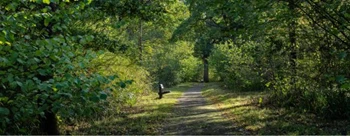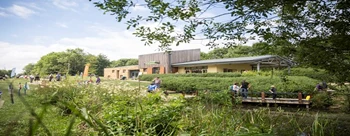Woodland Management
Management of the Ancient semi-natural Woodlands
We manage three mature woodlands (around 90 hectares in total) within Milton Keynes - Linford, Shenley and Howe Park Wood. These woodlands, and smaller pockets of woodland such as Kingsmead, are recognised as ancient semi-natural woodlands.
How were the woods managed historically?
For a woodland to be classified as such the wood needs to have existed before the year 1600, but our woods are much older than this. Two of them are referred in the Doomsday Book of 1086, and we think the third was probably referred to in the book under a different name.
For hundreds of years, from the Anglo-Saxon period to the Industrial Revolution, these woods played a vital role for the local community. Local lords held the rights over the woodlands and the evidence of medieval deer ditches at Howe Park and Linford Wood show that they would have kept and hunted deer here. Pigs, reared for food, would have roamed the woods. In addition to berries and nuts, these woods also supplied the local community with timber for building, fencing, charcoal, firewood, and general tools.
To provide many of these resources, the woods would have been managed using a ‘Coppice with standards’ system. This is a rotational system where the understorey shrubs; Such as Hazel, Hawthorn and Field Maple, would have been coppiced. This is the practice of cutting the shrub to just above ground level and then letting it re-grow. The upper canopy trees, which are called ‘standard trees’, would have been felled as required (e.g. building purposes). This action would allow the light into the understorey.
Looking at our three woodlands, studying old maps and knowing the growth rates, we think the coppicing cycle for these woodlands would have taken place every 12 – 15 years. So, working on a 15-year cycle, the wood would have been broken up into sections of about equal size and then, each year, one section of the woodland would have been worked upon. This was a sustainable way to provide the wood needed for the community.
What management methods do we use now?
We have adopted this ancient system of woodland management as the coppicing technique also benefits wildlife and woodland plants. As each area is coppiced and a small proportion of standard trees are removed, it allows light to reach the ground and the herbaceous plants dwelling here. Plants such as Bluebells, which can lay dormant for 30 years, react to the light and put on a massive flowering display. This in turn helps increase pollinators and invertebrates, offering feeding opportunities for birds and small mammals alike.
Meanwhile, areas that were coppiced three or four years ago start to grow again and, as they thicken up, they offer cover and retreat areas for mammals and nesting opportunities for birds. Feeding opportunities develop as the Hazel produces nuts and Hawthorns produce berries. This means that over the course of the 15 year cycle the habitat and density of woodland is always shifting. The insects, mammals and birds will move around the wood using the habitat that suits them at that time. The great thing the ‘coppice with standards’ system offers wildlife is that over the whole wood, there is both continuity and choice of habitat type. There are also occasions when we have to remove ash trees due to ash dieback.
Today, the woodlands are rich in wildlife and plant life. Rare butterflies such as the Black Hair Streak can be found in Howe Park Wood, which is a Site of Special Scientific Interest (SSSI). Great Crested Newts can be found in the woodland ponds and there are lots of rare invertebrates found in the woods, along with numerous specialist and ancient woodland indicating plants.
Planned management and an experienced team
All three mentioned woodlands (and all the developing plantations we manage) are subject to our own and Forestry Commission 10-year woodland management plan, that have very clear work programmes to bring the best out of the woods. Management Plans prepared for Howe Park Wood, which has a Site of Special Scientific Interest (SSSI) are also approved by Natural England, who at regular intervals, inspect the woods to ensure they are being managed correctly. We have highly qualified and experienced forestry and tree managers within our team who, in conjunction with our Biodiversity Managers, prepare such plans and oversee the work.
Why are some paths so wet during the winter?
Our woodlands are traditionally in wet areas which is the reason the woodlands have thrived for so long. This does mean that during the wet winter months some paths become water logged and impassable. To keep paths open, attractive and dry, we often carry our cutting work that favours herbaceous plants alongside the wood paths. We have different types of paths; binded stone surfaced paths, grass paths and woodchip surfaced paths to make sure that people can always enjoy the woodlands in Milton Keynes. We ask and encourage people to keep to these paths to enable the surrounding woodland to thrive.










